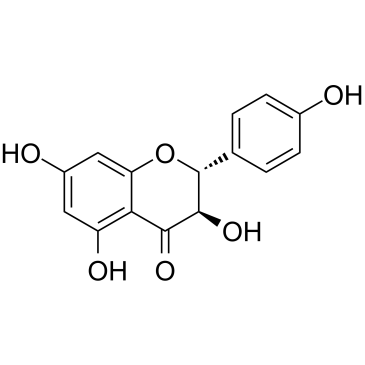Aromadendrin

Aromadendrin structure
|
Common Name | Aromadendrin | ||
|---|---|---|---|---|
| CAS Number | 480-20-6 | Molecular Weight | 288.252 | |
| Density | 1.6±0.1 g/cm3 | Boiling Point | 639.0±55.0 °C at 760 mmHg | |
| Molecular Formula | C15H12O6 | Melting Point | N/A | |
| MSDS | Chinese USA | Flash Point | 247.3±25.0 °C | |
| Symbol |

GHS07 |
Signal Word | Warning | |
|
Transcriptome sequencing and metabolite analysis reveals the role of delphinidin metabolism in flower colour in grape hyacinth.
J. Exp. Bot. 65(12) , 3157-64, (2014) Grape hyacinth (Muscari) is an important ornamental bulbous plant with an extraordinary blue colour. Muscari armeniacum, whose flowers can be naturally white, provides an opportunity to unravel the complex metabolic networks underlying certain biochemical tra... |
|
|
Functional characterization of a Plagiochasma appendiculatum flavone synthase I showing flavanone 2-hydroxylase activity.
FEBS Lett. 588(14) , 2307-14, (2014) FNS I is a 2-oxoglutarate dependent dioxygenase (2-ODD) found mainly in species of the Apiaceae family. Here, an FNS I cDNA sequence was isolated from the liverwort Plagiochasma appendiculatum (Aytoniaceae) and characterized. The recombinant protein exhibited... |
|
|
Production of 7-O-methyl aromadendrin, a medicinally valuable flavonoid, in Escherichia coli.
Appl. Environ. Microbiol. 78(3) , 684-94, (2012) 7-O-Methyl aromadendrin (7-OMA) is an aglycone moiety of one of the important flavonoid-glycosides found in several plants, such as Populus alba and Eucalyptus maculata, with various medicinal applications. To produce such valuable natural flavonoids in large... |
|
|
5-O-glucosyldihydroflavones from the leaves of Helicia cochinchinensis.
Phytochemistry 67(24) , 2681-5, (2006) From the leaves of Helicia cochinchinensis, collected on Okinawa Island, seven phenolic glucosides and two terpenic glucosides were isolated. Five of the phenolic glucosides were previously known, being identified with p-coumaric and ferulic acids glucosyl es... |
|
|
7-O-methylaromadendrin stimulates glucose uptake and improves insulin resistance in vitro.
Biol. Pharm. Bull. 33(9) , 1494-9, (2010) The stimulation of glucose uptake into peripheral tissues is an important mechanism for the removal of glucose in blood and for the management of diabetes mellitus (DM). Since recent results have demonstrated the beneficial effects of flavonoids in relation t... |
|
|
Stimulation of glucose uptake and improvement of insulin resistance by aromadendrin.
Pharmacology 88(5-6) , 266-74, (2011) Agents that stimulate glucose uptake and improve insulin resistance may be useful in the management of type 2 diabetes mellitus (DM). Thus, the aims of this study were to assess the effects of aromadendrin, a flavonoid from Gleditsia sinensis Lam., on stimula... |
|
|
Structural investigation of biologically active phenolic compounds isolated from European tree species.
Molecules 14(10) , 4147-58, (2009) X-ray structures of two compounds isolated from wood knots of coniferous trees, namely dihydrokaempferol (3,5,8,13-tetrahydroxyflavanon) and lariciresinol (3,14-dimetoxy-7,10-epoxylignan-4,15,19-triol), are presented here. Diffraction data for the Dihydrokaem... |
|
|
Preliminary investigation of naringenin hydroxylation with recombinant E. coli expressing plant flavonoid hydroxylation gene.
Nat. Prod. Commun. 5(5) , 777-82, (2010) Flavonoid hydroxylation is one way to increase the biological activities of these molecules and the number of hydroxyl groups needed for polymerization, esterification, alkylation, glycosylation and acylation reactions. These reactions have been suggested as ... |
|
|
Examination of the phenolic profile and antioxidant activity of the leaves of the Australian native plant Smilax glyciphylla.
J. Nat. Prod. 76(10) , 1930-6, (2013) Together with the sweet principle component glycyphyllin A (3), seven phenolic compounds including two new dihydrochalcone rhamnopyranosides, glycyphyllin B (1) and glycyphyllin C (2), and five known flavonoids, catechin (4), kaempferol-3-O-β-D-glucopyranosid... |
|
|
A new chromone derivative from Berchemia lineata.
Yao Xue Xue Bao 45(9) , 1139-43, (2010) To study the chemical constituents from the root of Berchemia lineata (L.) DC., nine compounds were isolated from the EtOAc extract by using silica gel, RP-C18 silica gel column chromatography and preparative HPLC. Based on the spectroscopic analysis, their s... |